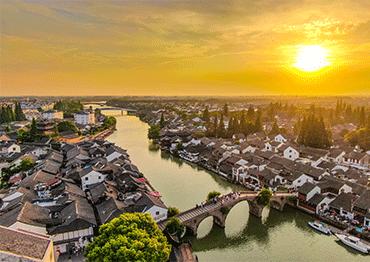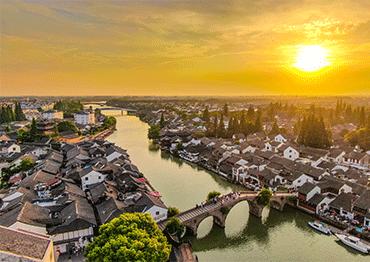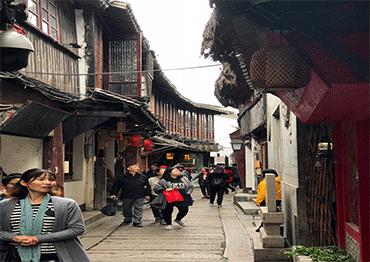It is strange how the most alien of places can sometimes feel the most like home. This is exactly how I felt when I first visited Zhujiajiao, and it is what has kept me revisiting year after year ever since. Zhujiajiao is a classic Chinese water town located in the Qingpu District of Shanghai. It was founded over 1,700 years ago and developed as a trading center for businesses specializing in rice and cloth. Nowadays, the small town has a population of less than 100,000 people, who are often dwarfed by the number of visiting tourists, especially on public holidays. Nevertheless, do not let this put you off visiting.
One of the interesting paradoxes is that although it technically sits within the boundaries of Shanghai, one of the largest cities in the world, Zhujiajiao can offer a peace and tranquillity hard to find elsewhere in China. The primary reason for this seeming paradox is that most tourists arrive for short day, or half-day, trips. As a result, after 5pm, the few remaining visitors find themselves almost alone to explore the town’s fascinating and stunning architecture. While the summer months offer visitors extended hours of outdoor enjoyment, the winter months offer visitors the opportunity to explore curious ancient streets, quaintly lit, with a gentle glow, as they enjoy a warm drink.
The most famous tourist attraction is Fangsheng Bridge, a stone arch bridge over one of the town’s widest canals. Originally built in 1571, it has been rebuilt many times. With five arches, it is the biggest bridge of its kind in Shanghai, and offers stunning views over the historic town center, both during the daytime and at night when the city is gently lit in a manner that compliments the medieval atmosphere. Over the years the bridge has been used for religious purposes, and it is not unheard of to see monks releasing live fish into the water below from the bridge. There are at least 35 other stone bridges criss-crossing the town’s canals, many of which are interesting, beautiful or have a curious story behind them. One is Ping’an Bridge, which the locals refer to as the Qi Family Bridge in honor of a famous general from the city. It is meant to bring good fortune for those whose journey across it, making it a popular detour for the superstitious. However, arguably the most aesthetic bridge is Tai’an Bridge, in large part due to its position at the intersection of two canals, and its proximity to gorgeous historic wooden buildings, which make it extremely photogenic.
Another popular attraction is Kezhi Garden. This site’s most interesting feature is the historic house, built in 1912, through which visitors must pass to reach the tranquil courtyards and gardens. The house is accessed off a bustling, narrow street packed with busy merchants, which stands in stark contrast to the meditative atmosphere of the house and its grounds. The house serves to remind visitors of the privilege and luxury that some families were able to enjoy in the town over the centuries, and how the peaceful lives of the elite stood in stark contrast to the hectic lives of ordinary people, who scurried busily through the warren of alleyways and scuttled around the maze of canals. Another classic Chinese garden in the city is the Garden of Inseparable Hearts, or Hexinyuan. While the garden offers a classical beauty, it is perhaps the adjoining museum, which attracts the most attention. The museum is of particular interest to people who admire historic stone tablets.
One of the most visible attractions of Zhujiajiao is Yuanjin Buddhist Temple, with its pagoda that towers over the small town and its adjoining lake. Like all other temples in Zhujiajiao, Yuanjin is small. However, I would argue that the manageable size of the complex makes the temple feel more accessible for visitors. Indeed, unlike many grand and glorified temples in China, awash with tourists, Yuanjin Temple feels like the active heart of a living and thriving local community. It feels like a working temple whose purpose has not been diluted by the modern era. Despite having been founded in 1341, the temple seems to have remained true to its original calling. The other major temple in the town, the City God Temple, is equally quaint, accessible and authentic, although one monk’s desperate attempts to elicit money from foreign visitors created a little social embarrassment upon my last visit.
Zhujiajiao is also home to several fascinating speciality museums, which can offer a much-needed break from the roaring heat of the summer. Quanhua Museum, although only opened in 2006, is set within a beautiful Qing Dynasty (1644-1911) building. The museum specializes in watercolors and hosts periodic displays from Chinese and international artists, although the museum’s main feature is the permanent collection of watercolors themed around the town of Zhujiajiao itself. More artworks can be found in Helong Art Museum, on the town’s North Street, which includes a broader range of artistic styles, dedicated to promoting the beauty of China and Chinese culture.
However, as a foreigner I find the Qing Dynasty Post Office to be by far the most fascinating of all the museums and attractions in Zhujiajiao. Interestingly, the Post Office seems to be less well known and less well regarded than many of the other sites. As a result, it is less visible in promotions, and can even be tricky to locate. Once inside the museum, visitors often have entire rooms to themselves to enjoy, even during the peak season. What I find so curious about the Qing Dynasty Post Office is that it represents a short-lived but tantalizing era when modernity clashed with tradition, and isolationism clashed with internationalism. Suddenly, Chinese emperors found themselves confronted with technologies and systems from the West, such as the railway and the postal service, that were inherently designed to promote communication and interaction across the globe. Inside the Post Office one can almost feel the dawn of a new era emerging and the conflicting desires of the elite classes to both embrace change and to resist it. Within a few decades the Qing Dynasty had fallen, and the world had entered a period of flux and change that continues to this day. Yet, as one strolls along the narrow, twisted, ancient streets of Zhujiajiao, one is reminded of the peace and serenity that comes from continuity and certainty. Just like the tranquil trees of Zhujiajiao’s Ginkgo Tree Square, which have stood for almost half a millennium, visitors to this town can pause, breathe deeply, and let time stand still in this home away from home.

 Old Version
Old Version

